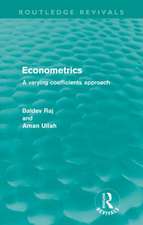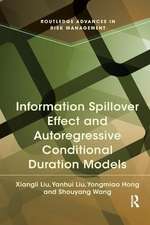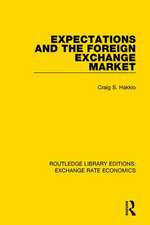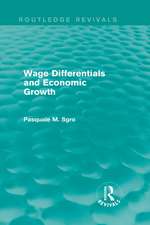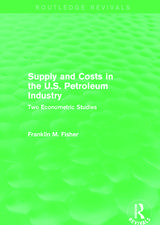Introduction to Spatial Econometrics: Statistics: A Series of Textbooks and Monographs
Autor James LeSage, Robert Kelley Paceen Limba Engleză Paperback – 21 ian 2023
Leaders in this field, the authors clarify the often-mystifying phenomenon of simultaneous spatial dependence. By presenting new methods, they help with the interpretation of spatial regression models, especially ones that include spatial lags of the dependent variable. The authors also examine the relationship between spatiotemporal processes and long-run equilibrium states that are characterized by simultaneous spatial dependence. MATLAB® toolboxes useful for spatial econometric estimation are available on the authors’ websites.
This work covers spatial econometric modeling as well as numerous applied illustrations of the methods. It encompasses many recent advances in spatial econometric models—including some previously unpublished results.
| Toate formatele și edițiile | Preț | Express |
|---|---|---|
| Paperback (1) | 341.55 lei 6-8 săpt. | |
| CRC Press – 21 ian 2023 | 341.55 lei 6-8 săpt. | |
| Hardback (1) | 796.59 lei 6-8 săpt. | |
| CRC Press – 20 ian 2009 | 796.59 lei 6-8 săpt. |
Din seria Statistics: A Series of Textbooks and Monographs
-
 Preț: 376.32 lei
Preț: 376.32 lei - 15%
 Preț: 487.33 lei
Preț: 487.33 lei -
 Preț: 436.14 lei
Preț: 436.14 lei -
 Preț: 436.18 lei
Preț: 436.18 lei - 20%
 Preț: 375.36 lei
Preț: 375.36 lei -
 Preț: 442.40 lei
Preț: 442.40 lei -
 Preț: 436.14 lei
Preț: 436.14 lei - 18%
 Preț: 1791.43 lei
Preț: 1791.43 lei - 14%
 Preț: 880.46 lei
Preț: 880.46 lei - 12%
 Preț: 312.91 lei
Preț: 312.91 lei -
 Preț: 389.38 lei
Preț: 389.38 lei - 12%
 Preț: 312.43 lei
Preț: 312.43 lei - 15%
 Preț: 489.26 lei
Preț: 489.26 lei -
 Preț: 436.14 lei
Preț: 436.14 lei - 20%
 Preț: 493.07 lei
Preț: 493.07 lei -
 Preț: 451.54 lei
Preț: 451.54 lei - 15%
 Preț: 489.26 lei
Preț: 489.26 lei -
 Preț: 436.14 lei
Preț: 436.14 lei -
 Preț: 439.25 lei
Preț: 439.25 lei -
 Preț: 323.23 lei
Preț: 323.23 lei - 15%
 Preț: 461.03 lei
Preț: 461.03 lei -
 Preț: 165.25 lei
Preț: 165.25 lei - 26%
 Preț: 1098.21 lei
Preț: 1098.21 lei - 15%
 Preț: 461.03 lei
Preț: 461.03 lei - 15%
 Preț: 461.03 lei
Preț: 461.03 lei - 31%
 Preț: 273.95 lei
Preț: 273.95 lei - 23%
 Preț: 378.29 lei
Preț: 378.29 lei -
 Preț: 440.61 lei
Preț: 440.61 lei -
 Preț: 435.98 lei
Preț: 435.98 lei -
 Preț: 436.14 lei
Preț: 436.14 lei - 15%
 Preț: 494.20 lei
Preț: 494.20 lei -
 Preț: 436.14 lei
Preț: 436.14 lei -
 Preț: 445.79 lei
Preț: 445.79 lei -
 Preț: 393.63 lei
Preț: 393.63 lei -
 Preț: 436.14 lei
Preț: 436.14 lei - 18%
 Preț: 858.71 lei
Preț: 858.71 lei -
 Preț: 436.14 lei
Preț: 436.14 lei - 20%
 Preț: 491.12 lei
Preț: 491.12 lei -
 Preț: 436.14 lei
Preț: 436.14 lei -
 Preț: 434.63 lei
Preț: 434.63 lei - 15%
 Preț: 461.03 lei
Preț: 461.03 lei - 12%
 Preț: 312.43 lei
Preț: 312.43 lei - 12%
 Preț: 327.92 lei
Preț: 327.92 lei -
 Preț: 436.36 lei
Preț: 436.36 lei - 25%
 Preț: 936.10 lei
Preț: 936.10 lei - 15%
 Preț: 568.28 lei
Preț: 568.28 lei
Preț: 341.55 lei
Nou
Puncte Express: 512
Preț estimativ în valută:
65.36€ • 68.55$ • 54.41£
65.36€ • 68.55$ • 54.41£
Carte tipărită la comandă
Livrare economică 01-15 aprilie
Preluare comenzi: 021 569.72.76
Specificații
ISBN-13: 9781032477749
ISBN-10: 1032477741
Pagini: 376
Ilustrații: 25
Dimensiuni: 156 x 234 x 46 mm
Greutate: 0.45 kg
Ediția:1
Editura: CRC Press
Colecția CRC Press
Seria Statistics: A Series of Textbooks and Monographs
ISBN-10: 1032477741
Pagini: 376
Ilustrații: 25
Dimensiuni: 156 x 234 x 46 mm
Greutate: 0.45 kg
Ediția:1
Editura: CRC Press
Colecția CRC Press
Seria Statistics: A Series of Textbooks and Monographs
Public țintă
Professional Practice & DevelopmentCuprins
Introduction. Motivating and Interpreting Spatial Econometric Models. Maximum Likelihood Estimation. Log-Determinants and Spatial Weights. Bayesian Spatial Econometric Models. Model Comparison. Spatiotemporal and Spatial Models. Spatial Econometric Interaction Models. Matrix Exponential Spatial Models. Limited Dependent Variable Spatial Models. References.
Recenzii
Altogether, this book should be of great value for everyone interested in spatial econometric models. It not only provides a thorough overview of the topic but also nicely illustrates the application of spatial econometrics for different types of data.
—Matthias Arnold, Statistical Papers (2011) 52
Without any doubt, the book by LeSage and Pace is a welcome addition to the spatial econometrics literature and will surely be a compulsory reference in this field. Although some good books on spatial statistics have come up in recent years, none of them is as specific as this one. … A nice feature of this text is that readers who are interested in implementing its methods could use MATLAB code that is publicly available on [two] Web sites … All in all we should thank the authors of this book for such a great effort in compiling and updating essential content of spatial econometrics.
—Journal of the Royal Statistical Society, Series A, April 2011
LeSage and Pace present a distinctive introduction to spatial econometrics. … Chapters 5 and 6 provide what might be considered the first in-depth review of Bayesian methods in a spatial econometric context, including approaches to model comparison. … a good introduction to the field. The outstanding overview of Bayesian spatial econometric methods and interesting discussions of not-so-introductory topics such as space time and limited dependent variable models make this a book worth having in your bookshelf.
—Journal of the American Statistical Association, Sept. 2010, Vol. 105, No. 491
Make room on your bookshelf. It is about time that such a text has been published. A variety of readers will gain from its breadth and timeliness. Students will be happy to find a single source of knowledge; faculty will be happy to have an updated text; and researchers will benefit from a comprehensive reflection on spatial econometrics. LeSage and Pace’s Introduction to Spatial Econometrics shines by offering a much-needed, state-of-the-art summary of spatial econometric methods.
—Kathleen P. Bell, Journal of Regional Science, Vol. 50, No. 5, 2010
… This textbook is a good resource for advanced undergraduate and graduate courses, and it provides a useful tool for empirical researchers who are interested in the application of spatial models. … [It] provides readers with a summary of some recent developments in spatial econometric models, especially with respect to the Bayesian approach. In addition, the book provides several chapters that are not treated formally in other similar textbooks, such as spatiotemporal models, matrix exponential spatial models, and limited dependent variable spatial models. With the empirical illustrations and MATLAB toolbox provided online, the book has a good balance of theoretical and empirical treatment of spatial models, and thus is a valuable reference for students and researchers who are interested in theoretical specifications and empirical applications of spatial models. … [it] fills some gaps in recent developments in spatial econometrics and updates some materials in the textbook of Anselin (1988). …
—Lung-Fei Lee and Jihai Yu, Geographical Analysis 42 (2010)
… a landmark in raising the bar in the field of applied spatial econometrics. … the state of the art of applied spatial econometrics has taken a step change with the publication of LeSage and Pace’s book. One can no longer restrict oneself to the spatial lag and/or the spatial error model, or to simply interpreting their point estimates and testing whether these point estimates are robust to different specifications of the spatial weights matrix. …
—Spatial Economic Analysis, Vol. 5, No. 1, March 2010
… the authors provide the right balance of theoretical detail and applied illustrations of the methods discussed. …The field is rapidly evolving and much of the material reflects recent ideas that have not appeared elsewhere. The text would be suitable for either an advanced undergraduate or a postgraduate course in spatial econometric modelling. … For those interested in implementing the methods and with knowledge of MATLAB, there is publicly available code which the authors refer to. The authors’ topic is an exciting area of statistics which will clearly evolve further and develop in the coming years. For these reasons alone, the text deserves wider exposure and the effort that will need to be invested in order to fully understand the material presented should be well rewarded.
—International Statistical Review, 2009
The research community needs a text like this … The LeSage and Pace text will become a standard reference in the field and will find a welcome home on the shelf of every empirical researcher interested in spatial econometric techniques.
—Donald Lacombe, Ohio University, Athens, USA
If you have any interest in using spatial econometrics, you must pick up a copy of the new text Introduction to Spatial Econometrics by James LeSage and R. Kelley Pace. It is extremely well written for an econometrics textbook, as it is very clear and very concise. … I give this textbook my highest recommendation.
—Justin M. Ross, Indiana University, Bloomington, USA
—Matthias Arnold, Statistical Papers (2011) 52
Without any doubt, the book by LeSage and Pace is a welcome addition to the spatial econometrics literature and will surely be a compulsory reference in this field. Although some good books on spatial statistics have come up in recent years, none of them is as specific as this one. … A nice feature of this text is that readers who are interested in implementing its methods could use MATLAB code that is publicly available on [two] Web sites … All in all we should thank the authors of this book for such a great effort in compiling and updating essential content of spatial econometrics.
—Journal of the Royal Statistical Society, Series A, April 2011
LeSage and Pace present a distinctive introduction to spatial econometrics. … Chapters 5 and 6 provide what might be considered the first in-depth review of Bayesian methods in a spatial econometric context, including approaches to model comparison. … a good introduction to the field. The outstanding overview of Bayesian spatial econometric methods and interesting discussions of not-so-introductory topics such as space time and limited dependent variable models make this a book worth having in your bookshelf.
—Journal of the American Statistical Association, Sept. 2010, Vol. 105, No. 491
Make room on your bookshelf. It is about time that such a text has been published. A variety of readers will gain from its breadth and timeliness. Students will be happy to find a single source of knowledge; faculty will be happy to have an updated text; and researchers will benefit from a comprehensive reflection on spatial econometrics. LeSage and Pace’s Introduction to Spatial Econometrics shines by offering a much-needed, state-of-the-art summary of spatial econometric methods.
—Kathleen P. Bell, Journal of Regional Science, Vol. 50, No. 5, 2010
… This textbook is a good resource for advanced undergraduate and graduate courses, and it provides a useful tool for empirical researchers who are interested in the application of spatial models. … [It] provides readers with a summary of some recent developments in spatial econometric models, especially with respect to the Bayesian approach. In addition, the book provides several chapters that are not treated formally in other similar textbooks, such as spatiotemporal models, matrix exponential spatial models, and limited dependent variable spatial models. With the empirical illustrations and MATLAB toolbox provided online, the book has a good balance of theoretical and empirical treatment of spatial models, and thus is a valuable reference for students and researchers who are interested in theoretical specifications and empirical applications of spatial models. … [it] fills some gaps in recent developments in spatial econometrics and updates some materials in the textbook of Anselin (1988). …
—Lung-Fei Lee and Jihai Yu, Geographical Analysis 42 (2010)
… a landmark in raising the bar in the field of applied spatial econometrics. … the state of the art of applied spatial econometrics has taken a step change with the publication of LeSage and Pace’s book. One can no longer restrict oneself to the spatial lag and/or the spatial error model, or to simply interpreting their point estimates and testing whether these point estimates are robust to different specifications of the spatial weights matrix. …
—Spatial Economic Analysis, Vol. 5, No. 1, March 2010
… the authors provide the right balance of theoretical detail and applied illustrations of the methods discussed. …The field is rapidly evolving and much of the material reflects recent ideas that have not appeared elsewhere. The text would be suitable for either an advanced undergraduate or a postgraduate course in spatial econometric modelling. … For those interested in implementing the methods and with knowledge of MATLAB, there is publicly available code which the authors refer to. The authors’ topic is an exciting area of statistics which will clearly evolve further and develop in the coming years. For these reasons alone, the text deserves wider exposure and the effort that will need to be invested in order to fully understand the material presented should be well rewarded.
—International Statistical Review, 2009
The research community needs a text like this … The LeSage and Pace text will become a standard reference in the field and will find a welcome home on the shelf of every empirical researcher interested in spatial econometric techniques.
—Donald Lacombe, Ohio University, Athens, USA
If you have any interest in using spatial econometrics, you must pick up a copy of the new text Introduction to Spatial Econometrics by James LeSage and R. Kelley Pace. It is extremely well written for an econometrics textbook, as it is very clear and very concise. … I give this textbook my highest recommendation.
—Justin M. Ross, Indiana University, Bloomington, USA
Notă biografică
James LeSage, Robert Kelley Pace
Descriere
Introduction to Spatial Econometrics presents a variety of regression methods for analyzing spatial data samples that violate the traditional assumption of independence between observations. It explores a range of alternative topics, including maximum likelihood and Bayesian estimation, various types of spatial regression specif

